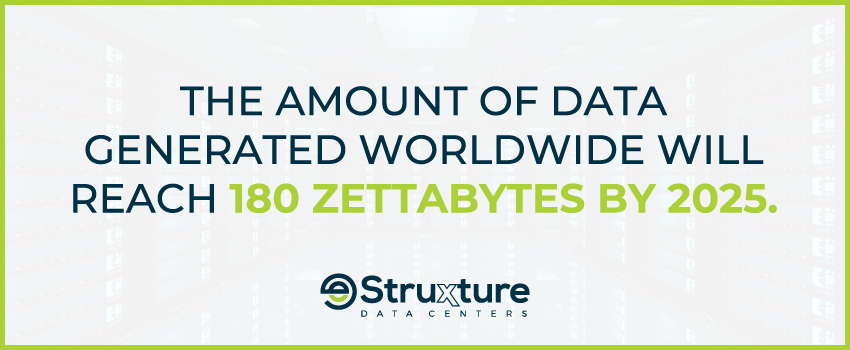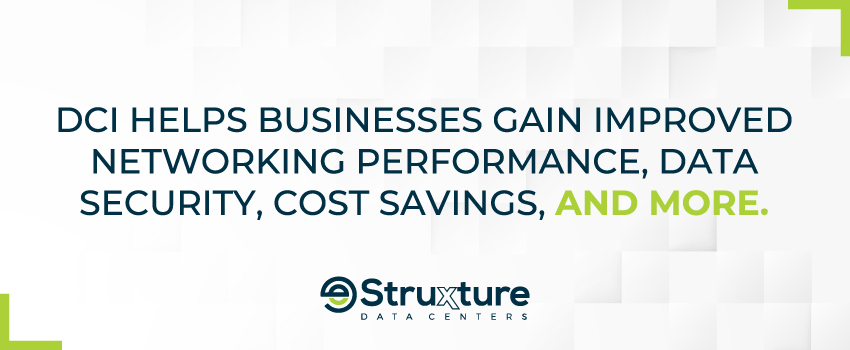What Is Data Center Interconnect (DCI)? A Comprehensive Guide
Jul 31, 2023
The Data Center Interconnect Market
There are an estimated 8,000 data centers worldwide,1 so chances are your business owns or connects to at least one – and likely more. However, data centers don't exist in isolation. They connect to other data centers, enabling companies like yours to send data wherever it needs to go.
Analysts expect data generated worldwide to reach 180 zettabytes by 2025.2 That's a lot of data to handle. Optimizing connectivity between data centers in the coming years will be vital. In this blog, we're exploring data center interconnect (DCI): what it does, why it's important for data center operators, and how it can benefit your business.
What Is Data Center Interconnect?
Data center interconnect technology connects multiple data centers, allowing them to share resources and operate as a single, integrated system. DCIs establish a fast, secure, and reliable connection between two data centers or more, regardless of distance. By connecting data centers, organizations can leverage their combined resources and computing power to quickly adapt to changing network traffic demands.
How Data Center Interconnect (DCI) Works
Here's a high-level overview of how DCI works:
Interconnection
The DCI network interconnects data centers by establishing a connection between their respective networking infrastructures. This can be achieved with physical connections, such as fiber optic links, or virtual connections using protocols like Virtual Private Networks (VPNs) or Multiprotocol Label Switching (MPLS) tunnels.
Data Transmission
Once the data centers are interconnected, data transmission can occur. Companies can exchange data, applications, and services across the DCI network in various formats, including file transfers, database replication, or real-time communication protocols.
Resource Sharing
DCI platforms share resources between interconnected data centers, so organizations can allocate resources and workloads across the data centers based on factors like demand, performance, or proximity.
Management and Orchestration
DCI networks require efficient management and orchestration, which allows administrators to configure, monitor, and control the network from a central location. Network management systems provide visibility into network performance, troubleshooting issues, and more.
How Data Center Interconnect (DCI) Transforms Key Industries
Supporting Healthcare Growth & Patient Care
DCI technology helps hospitals meet critical clinical needs by enabling seamless data movement between facilities. This allows healthcare providers to grow operations and deliver optimized patient care with improved efficiency.
Empowering Fintech with Reliable Infrastructure
In the fintech industry, DCI provides banks with the networking infrastructure needed to support digital products, including real-time payments, open banking, and other financial services.
Enabling Cloud Connectivity for Modern Enterprises
As more organizations migrate IT resources to multi-tenant and public clouds, DCI solutions play a vital role. They ensure seamless connectivity between enterprise data centers and cloud providers, driving scalability and performance.

Top Benefits of Data Center Interconnect (DCI) Technologies
Data center interconnect technologies offer several benefits for businesses, including:
Operational Simplicity
Data center interconnect platforms are designed to help organizations streamline operations with centralized management and simplified infrastructure. Instead of managing each data center separately, IT teams can treat interconnected data center facilities as a single system. And because data center interconnect services consolidate the connectivity between data centers, businesses no longer need to manage separate point-to-point connections or complex routing configurations.
Improved Performance
Since DCI shares computing resources and workload distribution across multiple data centers, businesses can improve performance by dynamically allocating resources based on demand. Administrators can easily move and balance applications across data centers, as well as apply quality of service (QoS) and other policies for optimal performance.
Seamless Scalability
As data and computing demands increase, companies using DCI can quickly add additional data center locations to the interconnected network. DCI lets organizations scale their network infrastructure by expanding computing capacity and accommodating growing workloads – without disrupting operations.
Data Security
DCI allows organizations to implement encryption protocols to secure data transfer and sharing between facilities. Access controls and authentication mechanisms like two-factor authentication (2FA) or multi-factor authentication (MFA) are also used to ensure that only authorized people and devices can send or access data via the DCI network.
More Flexibility
With DCI technology, IT teams can move data between data centers as needed to ensure it's accessible from multiple locations. This flexibility allows organizations to leverage data analytics, distribute workloads, and optimize data storage based on regional needs or compliance requirements. DCI also provides seamless data access to authorized users anywhere, allowing companies to support a work-from-anywhere environment.
Cost Optimization
Data center interconnect technology promotes optimized data center designs. Interconnecting data center locations reduces the need for duplicate hardware, software, and other physical infrastructure components, resulting in a more cost-efficient solution for procurement, maintenance, and operational expenses.

Boost Performance with Data Center Interconnect Solutions
Overcoming Scalability & Distance Constraints
Traditional solutions face challenges with scalability and distance limitations. Optimized DCI solutions enable seamless, high-capacity data transport across any distance.
Fine-Tuning Application Capacity
With programmable interfaces, businesses can fine-tune individual application capacity, delivering performance tailored to their IT demands.
Improving Network Efficiency
Advanced packet optimization techniques, including compression and data deduplication, enhance network throughput and reduce bandwidth utilization.
Optimizing Power & Space
Performance-optimized DCI solutions maximize service density while reducing power consumption and the overall data center footprint.
Key Components of Reliable & Efficient DCI Networks
DCI networks require several key components to maintain reliability and efficiency. Here are some of the essentials:
Scalable Connectivity
Scalable, high-speed connectivity is essential for accommodating large volumes of data transfer between data center facilities. This typically involves using a fiber optic connection, which offers sufficient bandwidth to handle the anticipated data traffic. Additionally, the network infrastructure should be flexible enough to support increasing bandwidth demands as your data requirements grow.
Redundant Architecture
DCI technology demands a reliable and redundant architecture to ensure continuous connectivity. Your business can achieve this by implementing redundant networking components such as routers, switches, and links. Redundant power supplies, backup systems, and failover mechanisms can also help mitigate the impact of equipment failures or network disruptions.
Efficient Traffic Management
Effective traffic management and load balancing are necessary for a DCI environment to optimize resource utilization and transfer data efficiently. This involves implementing traffic engineering techniques, QoS mechanisms, and intelligent routing protocols to distribute traffic and prevent congestion.
Reduced Footprint
While reducing the footprint isn't a strict requirement for DCI networks, many companies prefer it due to the cost savings and efficiency it provides. A compact DCI network design requires less space, resulting in lower construction, power, and cooling costs and allowing for easier scalability and future expansion.
Open APIs
DCI networks often benefit from open APIs, which allow networking systems from different vendors to communicate and work together seamlessly. Open interfaces facilitate interoperability between components, such as routers and switches, for smooth network management, so you can avoid vendor lock-in and select the best technologies for your needs.
Exploring Data Center Interconnect Options
Selecting the right Data Center Interconnect (DCI) solution ensures secure, high-performance connectivity between facilities. Below are the most common and advanced options:
Point-to-Point Connections
A dedicated, Layer 2 Ethernet link offering low-latency, high-speed data transfer between two data centers. Ideal for consistent, real-time workloads.
Wavelength Services
Optical networking that provides high-capacity bandwidth (e.g., 10Gbps to 100Gbps), ideal for large-scale data transfers and high-traffic environments.
Dark Fiber Solutions
Unlit fiber infrastructure gives businesses full control and scalability. It’s customizable for maximum performance and efficiency across long distances.
IP/MPLS Networks
These multi-site interconnection solutions use intelligent traffic routing and redundancy for dynamic, geographically distributed workloads.
Virtual Private LAN Service (VPLS)
VPLS enables a single, virtual Layer 2 network across multiple sites, creating a seamless, scalable solution for connecting distributed infrastructure.
SD-WAN for DCI
Software-defined WAN (SD-WAN) delivers flexible, secure interconnectivity by leveraging multiple connection types (MPLS, broadband, LTE) to optimize performance and costs.
Cloud Exchange Solutions
Cloud Exchange offers direct interconnection to public cloud providers like AWS, Azure, and Google Cloud, enabling businesses to integrate cloud and data center resources seamlessly.
Trust eStruxture for Data Centers That Give You More
Many organizations struggle to connect their data centers effectively and securely, especially as data and network traffic increase. Luckily, you have an alternative to costly data center construction and maintenance costs: colocation.
At eStruxture, you can connect to a vibrant ecosystem of network and cloud service providers with our carrier-neutral, secure colocation data centers. With 15 facilities spanning over 760,000 square feet across Canada, we can help you get the data center capacity, performance, and flexibility your business needs to run modern enterprise applications. Get in touch today to learn more.
Sources: